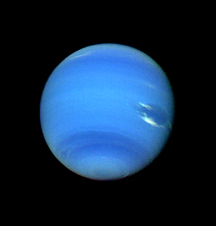
Geotimes Home | AGI Home | Information Services | Geoscience Education | Public Policy | Programs | Publications | Careers

 As Voyager
2 neared Uranus in January 1986, NASA scientists waited for the radio waves that
would be the first evidence of the gas giant’s predicted magnetic field.
They expected the field to be much like those of Jupiter, Saturn and Earth —
a large-scale, stable field, much like a bar magnet, with north and south poles
aligned along the planet’s axis of rotation. What they discovered instead
was a small-scale fluctuating field with multiple poles and a 60-degree tilt toward
the equator. Three years later, Voyager 2 flew by Neptune and detected a similar
field there. Until now, scientists have been unable to effectively model and explain
this odd behavior.
As Voyager
2 neared Uranus in January 1986, NASA scientists waited for the radio waves that
would be the first evidence of the gas giant’s predicted magnetic field.
They expected the field to be much like those of Jupiter, Saturn and Earth —
a large-scale, stable field, much like a bar magnet, with north and south poles
aligned along the planet’s axis of rotation. What they discovered instead
was a small-scale fluctuating field with multiple poles and a 60-degree tilt toward
the equator. Three years later, Voyager 2 flew by Neptune and detected a similar
field there. Until now, scientists have been unable to effectively model and explain
this odd behavior.Sara Pratt
Geotimes contributing writer
Back to top
 |
Geotimes Home | AGI Home | Information Services | Geoscience Education | Public Policy | Programs | Publications | Careers |